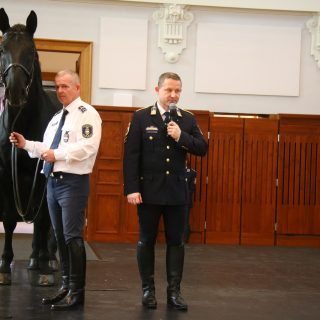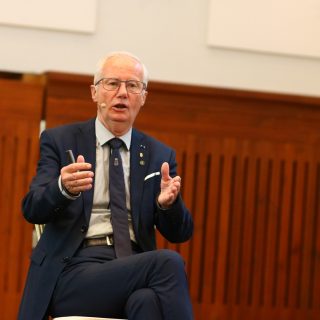Under the title “Horses in the Budavár Riding Hall – Anatomy, breeding, training,” engaging lectures were held on March 16th in Buda Castle. The organizers of the event will donate the revenue from ticket sales to support equestrian education. The event was honoured by the presence of Schmitt Pál, former President of Hungary and two-time Olympic champion fencer; Katalin Makray, the flagbearer of the University of Veterinary Medicine Budapest and Olympic silver medalist Hungarian gymnast; and Sándor Wladár, President of the Hungarian Swimming Association and Olympic champion swimmer.
The program began with a lecture titled “Living Anatomy” by Prof. Dr. Péter Sótonyi, the rector of the University of Veterinary Medicine Budapest. For an hour, the audience could experience what it’s like to be a university student – as, freshmen listen to their first anatomy lecture in the auditorium with the participation of horses facilitated by the Standby Police. The only difference this time was that before the introduction of the horses, anatomy notes containing the Latin terms to be learned were not distributed. Dr. Péter Sótonyi, who is also the vice president of the Hungarian Equestrian Federation, enthusiastically guided the audience into the secrets of the anatomy of these wonderful animals, expressing gratitude for the traditional involvement of the police in the successful execution of the first university anatomy class.
After the break, István Tibor Papp, President of the Hungarian Horse Breeders’ National Association and Mayor of Mezőhegyes, gave a lecture titled “Introduction to the world of horse breeding: Presentation of the Gidran and Nonius breeds.” He explained that one pillar of Hungary’s equestrian sector is the Hungarian Equestrian Federation, which encompasses equestrian disciplines, riders, sport horses, and organizes equestrian competitions. The other pillar is the Hungarian Horse Breeders’ National Association, which forms the basis of the sector, bringing together and organizing horse breeding in Hungary, resulting in a large number of sport horses, hobby horses, or even police horses. These two significant organizations in the equestrian sector emphasize that “there is no breeding without trial.”
In the third part of the event, Gyula Dallos, Ministerial Commissioner and Perpetual Hungarian Champion, a university equestrian instructor, gave a lecture titled “The role of the horse in the 21st century: The versatile training of horse and rider.” Starting with a historical overview, the expert demonstrated how to train a horse as a cooperative partner with its rider. The emphasis was on the versatile training of the rider. He detailed training characteristics, starting from the structure of training to teaching and learning ethics. Almost every sentence he uttered formulated a statement that could be discussed for hours. Finally, to illustrate his points, he presented details of the international successes achieved with the Aktion horse.
At the end of February, the Budavári Riding Hall hosted an event celebrating the centenary of the Hungarian Equestrian Federation, attended by Kristóf Szalay-Bobrovniczky, Minister of Defense, and Ingmar De Vos, President of the International Equestrian Federation (Fédération Equestre Internationale, FEI).
Over the past hundred years, the dedicated work of thousands of equestrians has laid bricks on top of each other, resulting in the stability, authority, and respect our beloved sport commands today, said Lázár Vilmos, president of the Hungarian federation, in his ceremonial speech.
In his midnight toast at the ceremonial gala, Prof. Dr. Péter Sótonyi, vice president of the Equestrian Federation, emphasized: “One hundred years ago, it took great courage to create something in a fragmented country that still endures to this day. I wish for us to be just as brave. And we hope that in 100 years, they will also remember us, those who are here today.”
Photos: Gusztáv Balázs












